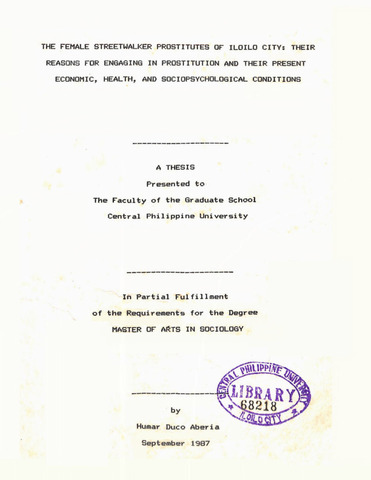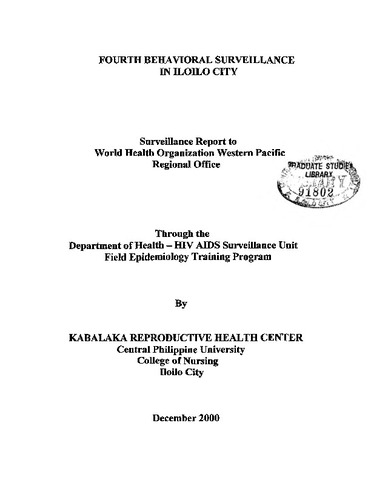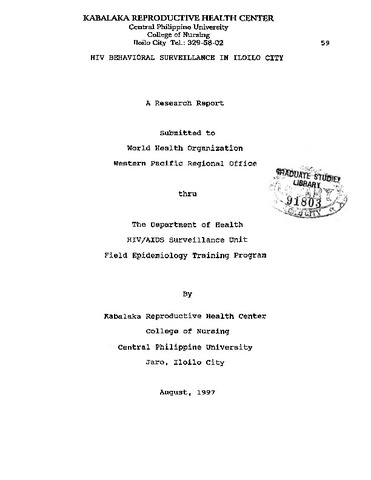The female streetwalker prostitutes of Iloilo City: Their reasons for engaging in prostitution and their present economic, health, and sociopsychological conditions
Résumé
The Study aimed to find out the reasons why some women became prostitutes; determine the demographic, educational, and educational characteristics of the prostitute's own or their parents family; and find out the present economic, health, and sociopsychological conditions of the prostitutes. Using a descriptive research design, quantitative and qualitative data were gathered from the streetwalker prostitutes of Iloilo City with the help of two hired interviewers and by the researcher. The first two respondents were identified with the help of informants, the succeeding respondents were located with the use of snowballing technique until a quota of 30 samples was reached. Results reveal that most prostitutes included in the study were in their early twenties, single, high school educated, and in-migrants from other places in the Visayas and Mindanao. Most prostitutes families were poor, with the average size slightly smaller than the regional and national averages, have completed one year of high school education, with one working member supporting less than one respondent. Most families depended on their heads while some depended on the prostitutes for their daily maintenance.
Women who became prostitutes due to poverty did voluntarily while some were recruited illegally. Keen competition among the numerous prostitutes in the city motivated them to employ different techniques, with some working with pimps to hook customers. Prostitutes selected customers primarily on the basis of their ability to pay using hotels as their favorite places for exchanging sexual favors. The nightly income of a prostitute which was higher than that of a public elementary and high school teacher, depended upon her looks, number of customers served, and her asking price. Many prostitutes were victims of sexual exploitation of some men including policemen and Philippine Constabulary troopers.
There was an alarming incidence of sexually-transmitted diseases among the prostitutes included in the study, the most common being gonorrhea. Most prostitutes submitted themselves for medical check-up while there were those who did not, for fear of being arrested once known. Some prostitutes continued practicing the trade in spite of their being infected by sexually transmitted diseases. Most parents knew that their daughters were prostitutes yet, in spite of their initial disapproval, they later on consented by allowing their daughters to support the education of their brothers and sisters. Most prostitutes were unhappy and dissatisfied with their trade and expressed their willingness to get out if decent and better-paying Jobs are made available to them. Like many human being, prostitutes have wishes for themselves and their families.
Description
Abstract only
Associated Content
Journal article published in Southeast Asia JournalSuggested Citation
Aberia, H. D. (1987). The female streetwalker prostitutes of Iloilo City: Their reasons for engaging in prostitution and their present economic, health, and sociopsychological conditions (Unpublished master thesis). Central Philippine University, Jaro, Iloilo City.
Type
ThesisSujet
Keywords
Department
School of Graduate StudiesDegree
Master of Arts in SociologyShelf Location
GSL Theses 300.72 Ab37
Physical Description
xvii, 138 leaves
Collections
Related items
Showing items related by title, author, creator and subject.
-
The female streetwalker prostitutes of Iloilo City: Their reasons for engaging in prostitution and their present economic, health, and sociopsychological conditions
Aberia, Humar D. (Central Philippine University, 1988)The study aimed to find out why some women became prostitutes, to determine the demographic and educational characteristics of the prostitutes’ own or their parents’ family; and to find out the present economic, health, ... -
Fourth behavioral surveillance in Iloilo City
Gumayan, Marian Vergie F. (Central Philippine University, 2000-12)Background/Rationale of the Study Behavioral surveillance in Iloilo City started on October 1997 when the Department of Health- Field Epidemiology Training program considered Iloilo City as one of their sentinel site. ... -
HIV behavioral surveillance in Iloilo City
Gumayan, Marian Vergie F.; Alibogha, Salex E.; Abioda, Nenalyn D.; Catedral, Mageline B. (1997-08)This HIV behavioral surveillance conducted in Iloilo City was designed to complement the HIV serologic surveillance conducted since 1994 by the City Health Office and Iloilo Social Hygiene Clinic. This investigation aimed ...






